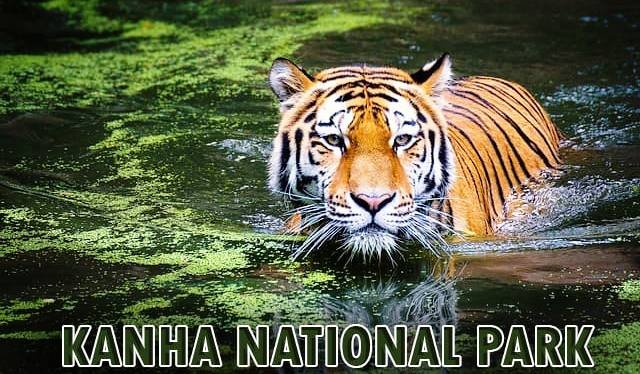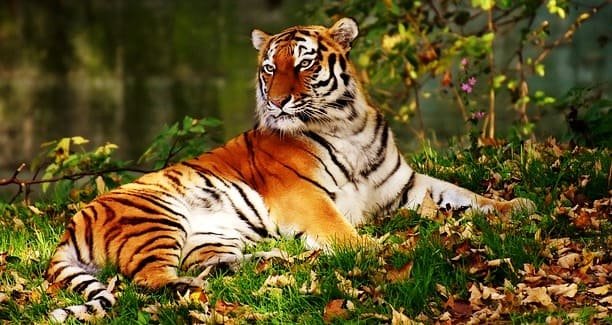Ultimate Guide to Kanha National Park

Introduction
Kanha National Park, a jewel in India’s wildlife crown, is located in the heart of Madhya Pradesh. Known for its rich biodiversity and mesmerizing landscapes, this park is a haven for nature lovers and wildlife enthusiasts. In this article, we’ll explore the key aspects of Kanha National Park, including its formation, wildlife, safari details, and much more.
Formation Date and Area
Kanha National Park was established in 1955 and later became part of the Kanha Tiger Reserve in 1973 under Project Tiger. The park spans an impressive area of 940 square kilometers, making it one of the largest national parks in Central India.
First Tiger and Their Numbers
The park’s first recorded tiger, famously known as Munna, was sighted in the early years of its establishment. Over the decades, the tiger population in Kanha has flourished. As of the latest census, Kanha National Park is home to around 100 tigers, showcasing a successful conservation story.
Entry Gates for Safari
Kanha National Park has four main entry gates for safaris:
- Kisli Gate
- Mukki Gate
- Sarhi Gate
- Khatia Gate
These gates provide access to different zones of the park, each offering unique wildlife sightings and scenic beauty.
Safari Booking Process
Booking a safari in Kanha National Park can be done online through the official Madhya Pradesh Forest Department website or through authorized travel agents. Here’s a step-by-step guide:
- Visit the official website: MP Forest Department
- Choose the park and gate: Select Kanha National Park and your preferred entry gate.
- Select the safari type: Options include Jeep Safari, Canter Safari, and Elephant Safari.
- Provide visitor details: Enter the names and IDs of all visitors.
- Make the payment: Pay the safari charges online to confirm your booking.
- Receive confirmation: Print or save the booking confirmation for entry at the gate.
Safari Charges and Time Duration
Safari Charges
- Jeep Safari: Approximately INR 2,500 – 3,500 per Jeep (max 6 people)
- Canter Safari: Approximately INR 500 – 800 per person
- Elephant Safari: Approximately INR 1,000 – 2,000 per person
Time Duration
- Morning Safari: 6:00 AM – 11:00 AM
- Afternoon Safari: 3:00 PM – 6:00 PM
Stay Arrangements
Kanha National Park offers a range of accommodation options, from budget lodges to luxury resorts. Some popular stay options include:
- Kanha Earth Lodge
- Singinawa Jungle Lodge
- Tuli Tiger Resort
- Club Mahindra Kanha Resort
- Motel Chandan
These accommodations provide a comfortable stay with amenities such as guided tours, nature walks, and cultural experiences.
Current Tiger Population
As of the latest reports, Kanha National Park hosts approximately 100 tigers, making it one of the prime tiger habitats in India.
Famous Tiger in Kanha National Park
The most famous tiger in Kanha National Park is Munna, known for the distinctive “CAT” mark on his forehead. Munna has been a star attraction for visitors and a symbol of the park’s successful conservation efforts.
Animals Found in Kanha National Park
| Animal | Scientific Name |
|---|---|
| Bengal Tiger | Panthera tigris tigris |
| Indian Leopard | Panthera pardus fusca |
| Sloth Bear | Melursus ursinus |
| Indian Wild Dog | Cuon alpinus |
| Barasingha (Swamp Deer) | Rucervus duvaucelii |
| Indian Bison (Gaur) | Bos gaurus |
| Sambar Deer | Rusa unicolor |
| Spotted Deer (Chital) | Axis axis |
| Indian Fox | Vulpes bengalensis |
| Jungle Cat | Felis chaus |
State and Jurisdiction
Kanha National Park is located in the state of Madhya Pradesh and falls under the jurisdiction of the Madhya Pradesh Forest Department. The park is managed by the Kanha Tiger Reserve authority, which ensures the protection and conservation of its flora and fauna.

Other Information
Best Time to Visit
The best time to visit Kanha National Park is from October to June, with peak wildlife sightings typically occurring between March and June. The park is closed to visitors during the monsoon months of July, August, and September.
Flora and Fauna
Kanha is not only famous for its tigers but also for its rich biodiversity. The park is home to over 300 bird species, numerous reptiles, and a variety of plant species, including Sal and Bamboo forests.
Conservation Efforts
Kanha National Park has been a pioneer in wildlife conservation, particularly for the Barasingha or Swamp Deer, which was on the brink of extinction. The park’s efforts have led to a significant increase in the Barasingha population, earning it the nickname “Kanha’s Jewel.”
You Can Also Like
| Title | Link |
|---|---|
| Most Dangerous Snakes in the World | Most Dangerous Snakes in the World |
| The Ultimate Guide to Snakes: Venomous, Semi-Venomous, and Non-Venomous | The Ultimate Guide to Snakes: Venomous, Semi-Venomous, and Non-Venomous |
| History of Snakes: Evolution, Habitats, and Survival | History of Snakes: Evolution, Habitats, and Survival |
Famous Tigers in Kanha Tiger Reserve
| Tiger Name | Notable Characteristics | Current Status |
|---|---|---|
| Munna | Known for the “CAT” mark on his forehead | Deceased |
| Bheema | Renowned for his massive size | Alive |
| Chhoti Mada | Famous female tiger known for her agility | Alive |
| Bajrang | Noted for his powerful build and dominance | Alive |
| Dhamangaon Male | Dominant male of the Dhamangaon region | Alive |
| Langda | Known for his distinctive limp | Deceased |
| Naina | Known for her beautiful eyes and grace | Alive |
| Umarpani Male | Dominant male of the Umarpani area | Alive |
| Mahavir | Young and energetic tiger making a name for himself | Alive |
| Neelam | Female tiger known for her hunting skills | Alive |
1. Munna
- Notable Characteristics: Known for the “CAT” mark on his forehead.
- Interesting Facts: Munna was a true legend in Kanha. Imagine spotting a tiger with the letters “C-A-T” naturally etched on his forehead! This unique marking made Munna a superstar among visitors. He ruled his territory with authority and grace, becoming an unforgettable icon in the reserve’s history.
2. Bheema
- Notable Characteristics: Renowned for his massive size.
- Interesting Facts: Bheema is one of those tigers that leaves you in awe with his sheer size. Picture a tiger that looks like he could take on anything – that’s Bheema for you. Despite his formidable appearance, he’s known to be quite the laid-back giant, often seen relaxing by water bodies.
3. Chhoti Mada
- Notable Characteristics: Famous female tiger known for her agility.
- Interesting Facts: Chhoti Mada is the epitome of a supermom. Agile and quick, she’s raised several litters successfully. Seeing her gracefully move through the dense forest with her cubs is a sight to behold. Her mothering skills and agility make her a beloved resident of Kanha.
4. Bajrang
- Notable Characteristics: Noted for his powerful build and dominance.
- Interesting Facts: Bajrang is like the king of his jungle. With a powerful build, he’s known to fiercely defend his territory. His presence alone demands respect, and he’s often seen patrolling his domain, ensuring everyone knows who’s in charge.
5. Dhamangaon Male
- Notable Characteristics: Dominant male of the Dhamangaon region.
- Interesting Facts: The Dhamangaon Male is a classic example of a territorial tiger. Always on the move, patrolling his region, he’s a vigilant guardian of his domain. Observing his interactions and territorial behavior gives a real insight into the life of a dominant male tiger.
6. Langda
- Notable Characteristics: Known for his distinctive limp.
- Interesting Facts: Langda’s story is truly inspiring. Despite suffering an injury that gave him a limp, he adapted and thrived in the wild. His resilience and determination are a testament to the incredible survival instincts of tigers. Langda is a symbol of strength and perseverance.
7. Naina
- Notable Characteristics: Known for her beautiful eyes and grace.
- Interesting Facts: Naina, which means “eyes,” is famous for her mesmerizing gaze. Her beautiful eyes and graceful movements make her a favorite among photographers. Watching Naina in her natural habitat feels like witnessing a real-life fairy tale.
8. Umarpani Male
- Notable Characteristics: Dominant male of the Umarpani area.
- Interesting Facts: The Umarpani Male is a strategic and strong tiger. His dominance in the Umarpani area is well-established, and he’s known for his tactical prowess. Observing his methods of maintaining control over his territory is fascinating for wildlife enthusiasts.
9. Mahavir
- Notable Characteristics: Young and energetic tiger making a name for himself.
- Interesting Facts: Mahavir is the young dynamo of Kanha. Full of energy and curiosity, he’s quickly becoming a standout tiger. His adventurous spirit and boldness are exciting to watch, and he’s definitely one to keep an eye on as he continues to make his mark.
10. Neelam
- Notable Characteristics: Female tiger known for her hunting skills.
- Interesting Facts: Neelam is a master huntress and a caring mother. Her efficiency in hunting and dedication to her cubs make her a remarkable figure in Kanha. Neelam’s prowess and maternal instincts have earned her a special place in the hearts of those who follow her story.
These tigers each bring their unique charm and stories to the vibrant tapestry of Kanha Tiger Reserve. From legendary marks to incredible resilience, they are the stars that make Kanha a magical place for wildlife enthusiasts.
Conclusion
Kanha National Park is a true wildlife paradise, offering visitors a chance to witness India’s incredible biodiversity up close. Whether you’re passionate about wildlife, a lover of nature, or just looking for a peaceful getaway, Kanha offers an experience you’ll never forget. Plan your visit, book your safari, and immerse yourself in the wild beauty of Kanha National Park.
Frequently Asked Questions (FAQ)
1. What is the best time to visit Kanha National Park?
The best time to visit Kanha National Park is from October to June. The peak wildlife sightings typically occur between March and June. The park is closed to visitors during the monsoon months of July, August, and September.
2. How do I book a safari in Kanha National Park?
Booking a safari can be done online through the official Madhya Pradesh Forest Department website or via authorized travel agents. Here’s a quick guide:
- Visit the official website: MP Forest Department
- Select Kanha National Park and your preferred entry gate (Kisli, Mukki, Sarhi, Khatia).
- Choose the safari type: Jeep Safari, Canter Safari, or Elephant Safari.
- Enter the details of all visitors.
- Make the payment online to confirm your booking.
- Print or save the booking confirmation for entry at the gate.
3. What are the safari charges in Kanha National Park?
- Jeep Safari: Approximately INR 2,500 – 3,500 per Jeep (max 6 people)
- Canter Safari: Approximately INR 500 – 800 per person
- Elephant Safari: Approximately INR 1,000 – 2,000 per person
4. What are the safari timings in Kanha National Park?
- Morning Safari: 6:00 AM – 11:00 AM
- Afternoon Safari: 3:00 PM – 6:00 PM
5. Where can I stay in Kanha National Park?
Kanha National Park offers a variety of accommodation options, ranging from budget lodges to luxury resorts. Some popular options include:
- Kanha Earth Lodge
- Singinawa Jungle Lodge
- Tuli Tiger Resort
- Club Mahindra Kanha Resort
- Motel Chandan
6. What kind of wildlife can I see in Kanha National Park?
Kanha is famous for its Bengal Tigers, but you can also spot Indian Leopards, Sloth Bears, Indian Wild Dogs, Barasingha (Swamp Deer), Indian Bison (Gaur), Sambar Deer, Spotted Deer (Chital), Indian Foxes, and Jungle Cats, among many other species.
7. How many tigers are there in Kanha National Park?
As of the latest reports, Kanha National Park is home to approximately 100 tigers. The park is known for its successful tiger conservation efforts.
8. Who is the most famous tiger in Kanha National Park?
The most famous tiger in Kanha National Park is Munna, known for the distinctive “CAT” mark on his forehead. Although Munna has passed away, his legacy continues to be celebrated.
9. What are the entry gates for safaris in Kanha National Park?
Kanha National Park has four main entry gates: Kisli Gate, Mukki Gate, Sarhi Gate, and Khatia Gate. Each gate provides access to different zones of the park, offering unique wildlife sightings and scenic beauty.
10. What is the history of Kanha National Park?
Kanha National Park was established in 1955 and became part of the Kanha Tiger Reserve in 1973 under Project Tiger. The park covers an area of 940 square kilometers and is one of the largest national parks in Central India.
11. What are the flora and fauna of Kanha National Park?
Kanha boasts over 300 bird species, numerous reptiles, and a variety of plant species, including Sal and Bamboo forests. It’s not just about tigers; the park’s rich biodiversity makes it a haven for nature lovers.
12. What conservation efforts are in place at Kanha National Park?
Kanha National Park has been a leader in wildlife conservation, especially for the Barasingha or Swamp Deer, which was once on the brink of extinction. The park’s dedicated efforts have significantly increased the Barasingha population, earning it the nickname “Kanha’s Jewel.”
13. What should I bring on a safari in Kanha National Park?
- Comfortable clothing in neutral colors
- Binoculars
- Camera with extra batteries
- Sunscreen and insect repellent
- Hat and sunglasses
- Water bottle and snacks
- Valid ID for entry
14. Can I visit Kanha National Park with children?
Absolutely! Kanha National Park is a fantastic place for family trips. The experience of spotting wildlife in their natural habitat can be both educational and exciting for children. Just ensure they follow the safety guidelines during safaris.
15. How can I contribute to the conservation efforts at Kanha National Park?
You can contribute by:
- Following park guidelines and respecting wildlife
- Avoiding littering and keeping the park clean
- Supporting local communities by purchasing local crafts and products
- Participating in and supporting wildlife conservation programs and initiatives
Plan your visit to Kanha National Park and immerse yourself in the wild beauty and incredible biodiversity this park has to offer. Happy safari!


